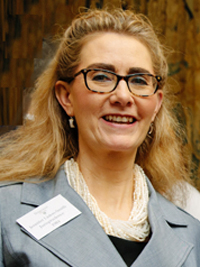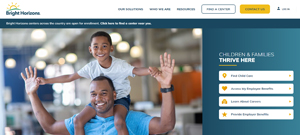Jennifer Liston-Smith is the head of thought leadership for Bright Horizons, a global provider of work and family solutions to employers and employees including childcare and back-up care for children and adults, as well as online and in-person toolkits, coaching and advice. A business psychologist, Jennifer was one of the UK pioneers of maternity coaching, supporting leading employers including global law firms, investment banks, accountancy firms, and other sectors, in retaining talent. More broadly, Jennifer is a diversity and inclusion thought leader with specialist expertise in work-life integration, transition and change, employee life stages, with a particular focus on parents and carers.

“During lockdown, the near-impossible task of combining a career with what we politely call ‘home-schooling’ has for many been an overwhelming schedule of trying to squeeze more hours into the day. We’ve heard about people working from 5 am until after midnight and couples taking two hours shifts, attending meetings alternating with engaging with children.”
Making work and family work
I started out thinking I wanted to be a barrister, but I followed my University of Oxford law degree with a masters in psychology, once I realised I was more interested in our inner conflicts than our legal disputes.
I briefly considered, but decided against, becoming a clinical psychologist, and in the end, I threw my energies into a career in learning and development as a business psychologist. However, alongside this, I carried on with 17 years’ voluntary work in a community mental health centre.
In my paid work, I was involved in one of the early waves of the workplace stress, well-being, and resilience movement in the 90s, designing and delivering programmes for large employers, as well as being a leadership coach as that new concept became established.
Having children gave me a whole new idea and, in the early 2000s, I was an innovator in the field of maternity coaching, and then later parent transition coaching, encouraging more gender-inclusive approaches. I co-founded a pioneering business in that field and was then invited to join My Family Care in 2010 to build and lead a coaching and consultancy department from the ground up, with a fantastic team of coaches, as well as originating the award-winning online Parental Leave Toolkit.
Along the way, I started getting involved in thought leadership by way of advice to the HR and diversity and inclusion leaders’ community, on best practice for employers of working parents and carers.

My role as head of thought leadership is quite varied and wide-ranging. I spend quite a bit of my time speaking at events for the HR leadership community, writing white papers and collaborating with internal and external colleagues to conduct and report on research relevant to our field. I also have a brief to support innovation within the business which involves lots of collaboration and communication with many different people and areas of the organisation.
Working through the era of children Zoom-bombing work meetings
The pandemic has had, as with so many businesses, quite a profound impact across Bright Horizons and very differently in different areas of the business.
In our nursery settings, some of which are community nurseries and some are client workplace nurseries, these went through various stages, following the guidelines set out by the Government, whether that meant closing for certain periods, remaining open only for children of key workers and vulnerable families, or where nurseries were open when schools were shut.
Throughout, and particularly at the latter stage against the backdrop of new variants and tighter lockdowns, our staff displayed huge resilience, creativity and bravery maintaining that provision. There was overwhelming feedback from parents to say how much they appreciated having those nursery settings open and what a difference it made to their ability to work.
From the perspective of our corporate clients, the pandemic has meant big changes including, for many, that shift to home working at a very large scale and on a global basis. Some of what we’ve been able to provide has evolved along the way. Emergency nannies, as a part of our Back-Up care provision, became more important than ever. This means somebody who is working from home with a crucial client meeting is able to work without children Zoom-bombing while the emergency nanny supervises them with their online schooling in another room.
Of course, there have been very strict coronavirus protocols supporting this, but during the most recent lockdown, for example, it’s been made very clear that childcare workers can enter other people’s homes and that has made a real difference for our clients.
Innovation when school’s out
Another innovation which supported clients is the provision of virtual holiday clubs: many of our clients’ employees rely on holiday clubs to provide cover during school holidays – alongside, of course, taking the time to spend with family too.
In recent times, those holiday clubs have been virtual holiday clubs and our partners providing those clubs have been able to offer a very educational and engaging experience conducted online but with a box of activities arriving at the door so the child or young person is genuinely active and able to interact independently with the holiday club, again while parents are free to continue working.
Some of those virtual holiday clubs or virtual out-of-school clubs have involved activities, such as coding or public speaking, making them really suitable and developmental for older children or teenagers – that’s been hugely welcomed by both our clients’ employees and our client partners as it’s demonstrated to their employees a real understanding of their position and willingness to support their needs.
Yet another innovation was the provision of pro bono webinars and online toolkits by our coaching team to support client employees themselves, as well as their managers, with everything from best practice for remote working, surviving in the school-free world to managing anxiety, and much more.
It’s vital to keep up the momentum with gender pay gap reporting
I am glad that gender pay gap reporting requirement has been reinstated this year, after a pause last year. It’s vitally important to keep up the momentum on this and also to prepare for ethnicity pay gap reporting, which will come before long, particularly if Stella Creasy’s Equal Pay (Information and Claims) Bill gets passed into legislation.

There has also been very helpful clarifying advice from the Equality and Human Rights Commission, advising that employees who were furloughed and on lower pay count towards the headcount (in terms of being an employer of over 250 people with a requirement to report), but that employees who were on a lower salary due to being furloughed (where their pay was not topped up) are not counted in terms of that hourly snapshot.
So, I think, armed with that information, it should be relatively straightforward for businesses to report. If we don’t report the figures then we lose the ability to compare year-on-year. Gender pay gap reporting always reflects a snapshot from a year earlier and we need to maintain that continuity.
The Equality and Human Rights Commission has given six months grace, so they won’t actually enforce reporting until October. However, my expectation, and hope, is that leading employers will report now in the existing window in order to keep up the momentum.
The process of gender pay gap reporting
Just to give a little bit of background on the gender pay gap reporting process, the duty to report arises from the Equality Act 2010 and the related regulations which came into force on April 6, 2017.
Essentially, employers with 250 or more employees must publish calculations every year showing how large any pay gap is between their male and female employees overall. It’s different from equal pay (much in the news at present with the supermarket cases) as it’s about the workforce overall, not only comparing pay in similar jobs.
A gender pay gap tends to show up where women have not progressed to higher-paid roles to the same extent as men or where there is gendered ‘career segregation’. For example, airlines have tended to have large gender pay gaps as more pilots are men and more cabin crew are women.
The data is based on a snapshot from the previous year (5th April or 31st March), for submission by 30th March 30/4th April. The March date is for public sector employers while private and voluntary sector employers use a snapshot date of 5th April and report by the following 4th April.
It is required to cover:
- mean (average) gender pay gap by hourly pay
- median gender pay gap by hourly pay
- percentage of men and women receiving bonus pay
- mean (average) gender pay gap by bonus pay
- median gender pay gap by bonus pay
- percentage of men and women across different levels of the organisation, using four pay quartiles
Gender pay gap information must remain on the employers’ websites for three years, so it will tell its own story. Therefore, including a narrative is an important chance to own the story and describe plans for closing a gap.
The near-impossible task of combining a career with ‘home-schooling’ during lockdown
This year’s gender pay gap figures relate to last year [2020] for the end of March/beginning of April, where we were only really beginning to see the impact of the pandemic; and apparently, early on, at least as many men as women were furloughed. The ability to request furlough as a parent was not clarified until later on.
If there is, as we keep hearing, a gendered impact of the pandemic in terms of women and particularly senior women falling out of the workforce as a result of the pandemic, then that would not really show until this year’s figures are reported in 2022.
During lockdown, the near-impossible task of combining a career with what we politely call ‘home-schooling’ has for many been an overwhelming schedule of trying to squeeze more hours into the day. We’ve heard about people working from 5am until after midnight and couples taking two hours shifts, attending meetings alternating with engaging with children. For some this has been unsustainable.
Leading employers are alert to this and also to the danger that those women who have remained in work may, deliberately or otherwise, take a step back career-wise if we let this trend play out without employers providing practical support and flexibility.
Of course, it’s important to say many fathers have also taken on a hands-on role in childcare and so we’re urging employers to be gender-inclusive in the ways they empower parents and carers with care solutions, coaching and advisory services.
How employers can help working parents
At this point I guess I could simply point to our website, as we’ve spent a couple of decades working out the blend of cultural, developmental, and practical measures that work, in simplest terms these are, care solutions, coaching and networks, and well-supported and equipped managers. That said, the other source to be aware of is that the Government Equalities Office has produced evidence-based guidance for employers on family-friendly actions to close the Gender Pay Gap, which is more relevant than ever and should be a timely part of every Gender Pay Gap Action Plan.
In terms of those recommendations, the conversation has moved on exponentially this year about flexible working, so a lot of ground has been covered there, which needs to be continued with well-developed plans for hybrid working.
In our clients’ experience, there has also been a huge step up in direct involvement in childcare provision by employers, particularly when the usual infrastructure was not operating. Commitments to keeping in touch during parental leave and supporting a confident return also matter more than ever in a remote or hybrid working world, as does inclusive leadership. We need to enable working parents, of all genders, to stay on a meaningful career track, not simply get by.
Taking forward what we have learnt
I’ve got a lot of conference speaking lined up at some large HR events which I really enjoy, particularly panel discussions when our clients join us to discuss their own experience.
We’ll be taking part in an HRD Connect webinar on 29th April, and also in the Festival of Inclusion in Hospitality, Travel and Leisure on 12th May, and in an HRreview webinar on 13th May. Those should be some really interesting conversations.
The other thing I’m excited about is that we recently surveyed our clients’ employees on their experience of the last year. It’ll be very interesting to compare this data with the random sample of over 1,000 working parents across the UK which we analysed for our Modern Families Index released in January.
I have a feeling it’s going to show that our clients’ employees are more comfortable with their employers’ approach to combining work and family than the random sample, but we’ll see what the data says shortly.
https://www.linkedin.com/in/listonsmith/
https://twitter.com/j_liston_smith
https://solutions.brighthorizons.co.uk/
https://www.linkedin.com/company/bright-horizons-uk/
https://twitter.com/bhfamiliesuk
Image credit of homeschooling – Photo created by pch.vector – www.freepik.com






